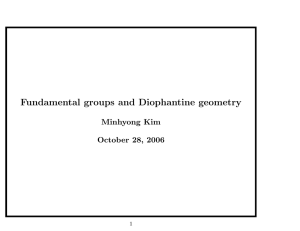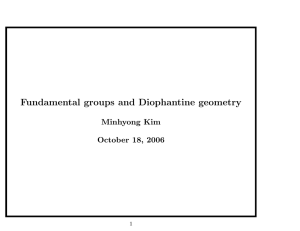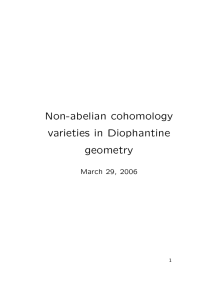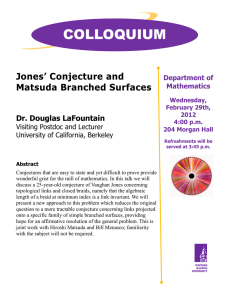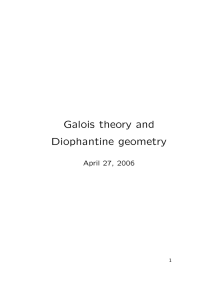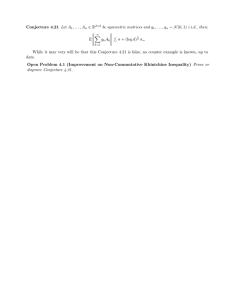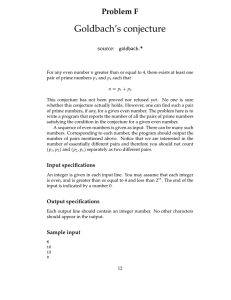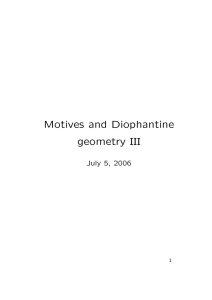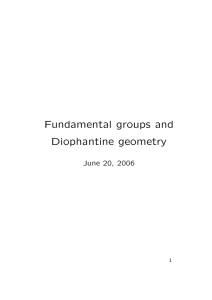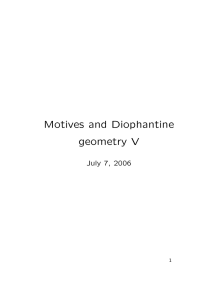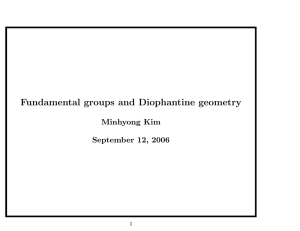Remark on fundamental groups and effective Diophantine methods for hyperbolic curves
advertisement
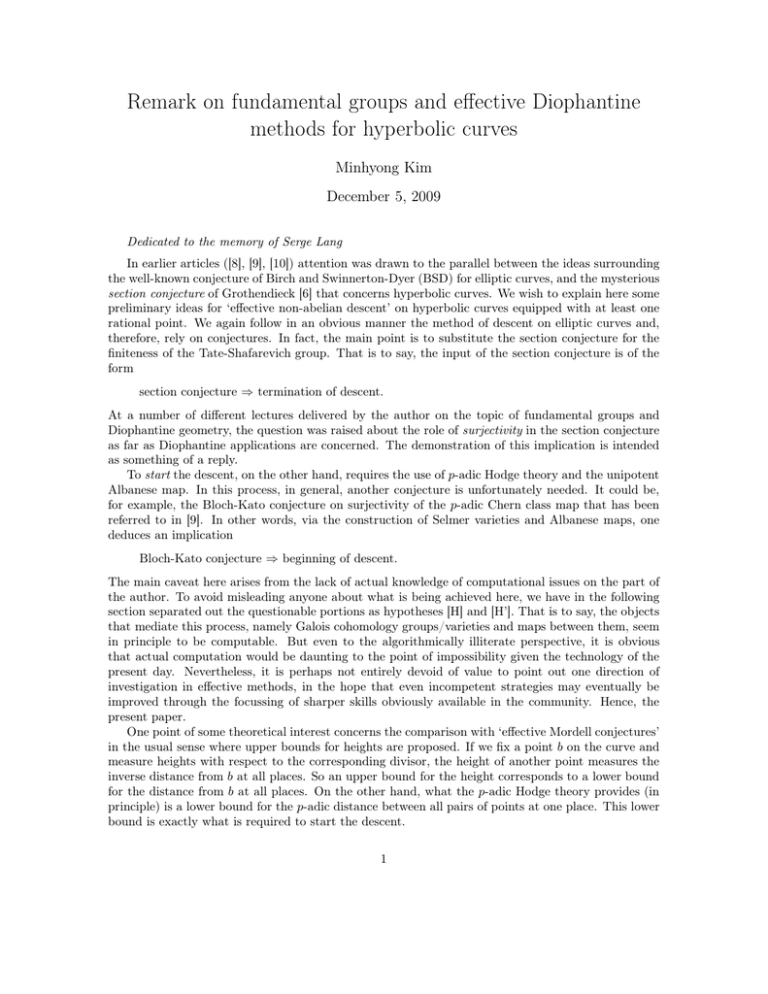
Remark on fundamental groups and effective Diophantine
methods for hyperbolic curves
Minhyong Kim
December 5, 2009
Dedicated to the memory of Serge Lang
In earlier articles ([8], [9], [10]) attention was drawn to the parallel between the ideas surrounding
the well-known conjecture of Birch and Swinnerton-Dyer (BSD) for elliptic curves, and the mysterious
section conjecture of Grothendieck [6] that concerns hyperbolic curves. We wish to explain here some
preliminary ideas for ‘effective non-abelian descent’ on hyperbolic curves equipped with at least one
rational point. We again follow in an obvious manner the method of descent on elliptic curves and,
therefore, rely on conjectures. In fact, the main point is to substitute the section conjecture for the
finiteness of the Tate-Shafarevich group. That is to say, the input of the section conjecture is of the
form
section conjecture ⇒ termination of descent.
At a number of different lectures delivered by the author on the topic of fundamental groups and
Diophantine geometry, the question was raised about the role of surjectivity in the section conjecture
as far as Diophantine applications are concerned. The demonstration of this implication is intended
as something of a reply.
To start the descent, on the other hand, requires the use of p-adic Hodge theory and the unipotent
Albanese map. In this process, in general, another conjecture is unfortunately needed. It could be,
for example, the Bloch-Kato conjecture on surjectivity of the p-adic Chern class map that has been
referred to in [9]. In other words, via the construction of Selmer varieties and Albanese maps, one
deduces an implication
Bloch-Kato conjecture ⇒ beginning of descent.
The main caveat here arises from the lack of actual knowledge of computational issues on the part of
the author. To avoid misleading anyone about what is being achieved here, we have in the following
section separated out the questionable portions as hypotheses [H] and [H’]. That is to say, the objects
that mediate this process, namely Galois cohomology groups/varieties and maps between them, seem
in principle to be computable. But even to the algorithmically illiterate perspective, it is obvious
that actual computation would be daunting to the point of impossibility given the technology of the
present day. Nevertheless, it is perhaps not entirely devoid of value to point out one direction of
investigation in effective methods, in the hope that even incompetent strategies may eventually be
improved through the focussing of sharper skills obviously available in the community. Hence, the
present paper.
One point of some theoretical interest concerns the comparison with ‘effective Mordell conjectures’
in the usual sense where upper bounds for heights are proposed. If we fix a point b on the curve and
measure heights with respect to the corresponding divisor, the height of another point measures the
inverse distance from b at all places. So an upper bound for the height corresponds to a lower bound
for the distance from b at all places. On the other hand, what the p-adic Hodge theory provides (in
principle) is a lower bound for the p-adic distance between all pairs of points at one place. This lower
bound is exactly what is required to start the descent.
1
Finally, we make the obvious point that the use of conjectures is probably not a serious obstacle
from the computational perspective (that is, in comparison to the problem of feasibility). This is in
the same spirit as the standard algorithms for computing Mordell-Weil groups of elliptic curves where
the BSD conjecture is employed with just a few misgivings [3].
1
Brief review
Here we will be intentionally brief, referring the reader to [4] and [9] for a more thorough discussion.
Let X/Q be a proper smooth hyperbolic curve of genus g with a point b ∈ X(Q) and let S be
the set of primes of bad reduction for X. In the following, we shall be a bit sloppy and mostly omit
et,Q
separate notation for an integral model of X. Choose a prime p ∈
/ S and let U et = π1 p (X, b) be
the Qp -unipotent étale fundamental group of X̄ := X ×Spec(Q) Spec(Q̄) and Unet = (U et )n+1 \U et its
quotient by the (n + 1)-th level of the descending central series normalized so that (U et )1 = U et . Let
Γ be the Galois group of Q̄ over Q. We defined the Selmer varieties
Hf1 (Γ, Unet )
([9], [10]) classifying Γ-equivariant torsors for Unet that are unramified at all places not in {p} ∪ S and
et
crystalline at p. (This is Hf1 (ΓT , Un−1
) in the notation of [8] and [9], where T = S ∪ {p}.) These are
affine algebraic varieties over Qp whose algebraic structures are defined inductively starting from
Hf1 (Γ, U1et ) ≃ Hf1 (Γ, H1et (X̄, Qp )),
which is a Qp vector space. Recall the fundamental diagram ([9], end of section 2)
X(Q)
⊂
- X(Qp )
κn dr
κet,loc
n
κet,glob
n
?
Hf1 (Γ, Unet )
/c
r
?
locD
p
1
et
Hf (Gp , Un )
Undr /F 0
Here, Hf1 (Gp , Unet ) classifies Gp := Gal(Q̄p /Qp )-equivariant torsors for Unet that are crystalline, while
Undr /F 0 classifies compatible pairs Tndr ≃ Tncr of torsors for the De Rham and crystalline fundamental
groups Undr and Uncr equipped with Hodge filtrations and Frobenius endomorphisms compatible with
the torsor structures. The maps associate to each point x ∈ X(Q) the class of the torsor of paths
from b to x in the appropriate category. So
et,Qp
κet,glob
(x) = [π1
n
with Γ-action,
et,Qp
κet,loc
(x) = [π1
n
(X̄; b, x)n ]
(X̄; b, x)n ]
with Gp -action, and
κdr/cr
(x) = [π1dr (X ⊗ Qp ; b, x) ≃ π1cr (Y ; b̄, x̄)]
n
where Y is the reduction mod p of a smooth Z[1/S] model for X.
In contrast to this mass of notation, the section conjecture considers just one map
κ̂ : X(Q)→H 1 (Γ, π̂1 (X̄, b))
that sends a point x ∈ X(Q) to the class of the pro-finite torsor of paths
π̂1 (X̄; b, x)
2
with Γ-action. It proposes that this map should be a bijection. The injectivity is already known
as a consequence of the Mordell-Weil theorem for the Jacobian J of X, while the surjectivity seems
to be a very deep problem. The question mentioned in the introduction arises exactly because the
injectivity appears, at first glance, to be more relevant for finiteness than the surjectivity. The idea for
using the bijectivity seems to have been to create a tension between the compact pro-finite topology
of H 1 (Γ, π̂1 (X̄, b)) and the ‘discrete nature’ of X(Q). At present it is unclear how this intuition is to
be realized. But, as mentioned, when the finiteness is obtained through a different approach, we wish
to explain the use of the surjectivity for finding the full set of points.
Using the exact sequence
0→U n+1 \U n →Un+1 →Un →0
for each of the fundamental groups, the global Selmer variety is fibered according to the sequence
et
)→Hf1 (Γ, Unet ),
0→Hf1 (Γ, (U et )n+1 \(U et )n )→Hf1 (Γ, Un+1
which means that the kernel acts on the variety in the middle with orbit space a subset of the third
object. If we denote by rn the dimension of Un , there is a recursive formula [11]
p
p
Σi|n iri = (g + g 2 − 1)n + (g − g 2 − 1)n
which implies in particular that
rn = (g +
p
g 2 − 1)n /n + O(g n/2 )
for some O(g n/2 ) that can be explicitly computed.
The global Selmer variety has its dimension controlled by the Euler characteristic formula for the
cohomology of the group ΓT = Gal(QT /Q), where T = S ∪ {p} and QT is the maximal extension of
Q unramified outside T ([9], section 3). It reads
dimH 1 (ΓT , (U et )n+1 \(U et )n ) − dimH 2 (ΓT , (U et )n+1 \(U et )n ) = dim[(U et )n+1 \(U et )n ]− ,
where the minus in the superscript refers to the sign for the action of complex conjugation. The
dimension of this minus part can be estimated as follows. The action of complex conjugation on the
étale fundamental group U et is compatible with its action on the Betti realization U B of the motivic
fundamental group [4], according to which
(U B )n+1 \(U B )n
has a pure Hodge structure of weight n. So when n is odd, we get
dim[(U et )n+1 \(U et )n ]− = rn /2
But when n = 2m is even, there is the contribution from the (m, m) component to consider, which
can be complicated. This (m, m) component is a quotient of the (m, m)-part of
H1 (X(C), C)⊗2m
which has dimension
2m
m
2m
g . So for simplicity, we will just use the tautological estimate
dim[(U et )n+1 \(U et )n ]− ≤ rn
for n even.
In [9], section 3, we analyzed already the use of the corresponding Tate-Shafarevich groups
X2 ((U et )n+1 \(U et )n )) := Ker[H 2 (ΓT , (U et )n+1 \(U et )n )→ ⊕v∈T H 2 (Gv , (U et )n+1 \(U et )n )]
3
which is dual to
X1 (((U et )n+1 \(U et )n )∗ (1)) := Ker[H 1 (ΓT , ((U et )n+1 \(U et )n )∗ (1))→⊕v∈T H 1 (Gv , ((U et )n+1 \(U et )n )∗ (1))].
There is a Chern class map [1]
(1)
chn,1 : K2−n−1 (X n ) ⊗ Qp →H 1 (Γ, H n (X̄ n , Qp (1)))
for n 6= 1 whose image lies in a ‘geometric’ subspace
Hg1 (Gal, H n (X̄ n , Qp (1)))
that contains
X1 (H n (X̄ n , Qp (1))).
In fact,
X1 ([(U et )n+1 \(U et )n )]∗ (1))
is a subspace of X1 (H n (X̄ n , Qp (1))) because the representation (U et )n+1 \(U et )n is a direct summand of H1et (X̄, Qp )⊗n which, in turn, is a direct summand of (H n (X̄ n , Qp ))∗ . But Bloch and Kato
conjecture that
(1)
chn,1 : K2−n−1 (X n ) ⊗ Qp →Hg1 (Gal(Q̄/Q), H n (X̄ n , Qp (1)))
is an isomorphism. Thus, when n ≥ 2, we get
X1 ([(U et )n+1 \(U et )n )]∗ (1)) = 0
We recall the explicit bound for the local H 2 ([9], section 3). For v 6= p, we have
dimH 2 (Gv , (U et )n+1 \(U et )n ) ≤ ng n +
n(n − 1)
(2g)2 g n−2
2
while
dimH 2 (Gp , (U et )n+1 \(U et )n ) ≤ ng n
Finally, as regards the contribution of the Hodge filtration, we saw in loc. cit. that
F 0 ((U dr )n+1 \(U dr )n+1 ) ≤ g n
so that
dim(U dr )n+1 \(U dr )n+1 /F 0 ≥ rn − g n = (g +
2
p
g 2 − 1)n /n − g n + O(g n/2 ).
Beginning the descent
Since it costs very little extra work to define, we will in fact consider the refined Selmer variety
1
Hf,0
(Γ, Unet ) ⊂ Hf1 (Γ, Unet )
consisting of classes whose images in
Hf1 (Γ, U1et )
go to zero under all localization maps
loc
Hf1 (Γ, U1et ) →v H 1 (Gv , U1et )
1
for v 6= p. As explained in [10], the image of X(Q) under κet,glob
lies in Hf,0
(Γ, Unet ). From the
n
estimates of the previous section, it is obvious that
4
assuming the Bloch-Kato conjecture, there is an effectively computable t such that
1
dimHf,0
(Γ, Unet ) < dimUndr /F 0
for n ≥ t.
1
Of course the computation starts out with an estimate for dimHf,0
(Γ, U1et ) which according to the
1
usual BSD is the same as the Mordell-Weil rank of J. After that the dimension of dimHf,0
(Γ, Unet )
grows as a function of n with an explicit upper bound while the dimension of Undr /F 0 grows with an
explicit (and eventually bigger) lower bound. Written out, the estimate for growth looks like
1
et
1
et
dimHf,0
(Γ, U2n+1
) ≤ dimHf,0
(Γ, U2n
) + r2n /2 + |S|[(2n)g 2n +
(2n)(2n − 1)
(2g)2 g 2n−2 ] + (2n)g 2n
2
and
1
et
1
et
dimHf,0
(Γ, U2n+2
) ≤ dimHf,0
(Γ, U2n+1
)+r2n+1 +|S|[(2n+1)g 2n+1 +
(2n + 1)(2n)
(2g)2 g 2n−1 ]+(2n+1)g 2n+1
2
while
dimUn+1 ≥ dimUn + rn − g n
We eventually get an inequality
in the right direction because of the asymptotic behavior of rn . In
p
this regard, note that g + g 2 − 1 > g for g ≥ 2.
As a consequence of the discrepancy in dimension, the image of
1
D ◦ locp : Hf,0
(Γ, Utet )→Utdr /F 0
is not Zariski dense. In contrast to difficult sets like X(Q), the classifying spaces for torsors and the
maps between them are algebro-geometric objects which can be computed in principle. This should
work in the manner of computations with the usual method of Chabauty as appears, for example, in
[7] (cf. the discussion of θ in the introduction). In case this is not convincing, we will adopt it as an
additional hypothesis:
[H]: The map
1
D ◦ locp : Hf,0
(Γ, Utet )→Utdr /F 0
can be computed.
The end result of this is that assuming B-K and [H], we can find an algebraic function α on Utdr /F 0 ,
1
that vanishes on the image of Hf,0
(Γ, Utet ). Now, when we restrict α to X(Qp ) it becomes a linear
combination of p-adic iterated integrals. To elaborate on this point a little more, recall ([9], section
1) the description of the coordinate ring of the De Rham fundamental group U dr,0 for an affine curve
X 0 obtained by deleting some rational divisor from X. In this case, when we choose a collection
1
a1 , a2 , . . . , ak of algebraic differential forms on X 0 inducing a basis of Hdr
(X 0 ), the coordinate ring
dr,0
of U
has the form
Qp < aw >,
the Qp vector space generated by symbols aw , one for each finite sequence w of numbers from
{1, 2, . . . , k}. Furthermore, on X 0 (Zp ), there is a lifting (depending on the previous choice of basis)
Utdr,0
-
?
dr,0
X (Zp )
Ut /F 0
0
5
such that the restriction of aw for w = (i1 , i2 , . . . , il ) to X 0 (Zp ) has the form
Z z
aw (z) =
ai1 ai2 · · · ail
b
Also, there is a functorial map
Utdr,0 →Utdr
compatible with the Hodge filtration so that the function α on Utdr /F 0 can be lifted to Utdr,0 . That
is to say, one can construct a diagram
-
Utdr,0
0
X (Zp )
?
- U dr /F 0
t
enabling us to compute the restriction of α to X 0 (Zp ) in terms of the aw . The idea would be to carry
this process out for two separate affine X 0 so as to cover X(Zp ) and then to express α in terms of
iterated integrals on each affine open set. Of course, the problem of explicitly computing the local
liftings is also a daunting task, although possible in theory. The author makes no pretense of knowing,
as yet, how to reduce this to a tractable process. Perhaps it is safer to state it also explicitly as a
hypothesis:
[H’]: The map
Utdr,0
- U dr /F 0
t
can be computed.
Choose a representative y ∈ X(Qp ) for each point in Y (Fp ) (= X mod p) and a coordinate zy centered
at y. We must then approximate the zeros of α on X(Qp ) by expressing it as a power series in the zy .
This needs to be carried out to a sufficiently high degree of accuracy so that we can find an M and a
finite collection yi ∈ X(Qp ) for which
]yi [M := {x ∈ X(Qp )|zyi (x) ≤ p−M }
contains at most one zero of α. That is to say, we need to separate the zeros of α modulo pM . Note
that even at this point, since all expressions will be approximate, there would be no way to determine
which of the yi relate to actual points of X(Q), even though an upper bound for the number of points
may be available, as was emphasized by Coleman [2]. In fact, the process of separating the points
using small disks already seems to occur, at least implicitly, in the method of Coleman-Chabauty. In
the next section we will see how to combine that separation with the section conjecture.
We summarize the preceding passages as follows:
Observation 1 Assuming the Bloch-Kato conjecture and the hypotheses [H] and [H’], there is an
effectively computable M such that the map
X(Q)֒→X(Qp )→X(Z/pM )
is injective.
In our view, this statement is one rather essential justification for studying the Selmer varieties
and unipotent Albanese maps. That is, Faltings’ theorem as it stands does not seem to give, even in
principle, a way of getting at this sort of effectivity. To belabor the obvious, the point is that the map
X(Q)→X(Qp )
6
is not a priori (i.e., before finding X(Q)) computable, even in principle, in contrast to the algebraic
map
1
Hf,0
(Γ, Utet )→Utdr /F 0 .
When we embed X(Q) inside J(Q) using the base-point b, we see then that we have an injection
X(Q)֒→J(Z/pM ).
But the kernel of the reduction map
J(Q)→J(Z/pM )
is of finite index, and hence, contains N J(Q) for some N . For example, one could take N = |J(Z/pM )|,
which, in turn, can be computed from the formula
|J(Z/pM )| = p2g(M−1) |J(Fp )|,
since p is a prime of good reduction. So finally, we arrive at an effectively computable N such that
X(Q)→J(Q)→J(Q)/N J(Q)
is injective. Let T0 be S together with the set of primes dividing N and ΓT0 the fundamental group
of Spec(Z[1/T0 ]) with base-point given by Z[1/T0 ]֒→Q֒→Q̄. Thus we get an injection
X(Q)֒→H 1 (ΓT0 , J[N ])
that allows us to begin descent.
3
Non-abelian descent and its termination
Once we have the final conclusion of the previous section, we can dispense entirely with the unipotent
machinery and start to deal with the pro-finite formalism. There are many ways to construct a co-final
system for
∆ := π̂1 (X̄, b),
of which we will use one described in a letter from Deligne to Thakur [5]. Let Kn ⊂ ∆ be the
intersection of all open subgroups of index ≤ n. It is a characteristic open subgroup, and hence, we
can form the finite quotient ∆(n) := ∆/Kn . The order of this quotient has all prime divisors ≤ n. Let
Γn denote the fundamental group of Spec(Z[1/n!]). We also denote by π(n) the quotient of π̂1 (X, b)
by Kn , a group that fits into the exact sequence
0→∆(n)→π(n)→Γ→0.
For n larger than any prime in S, there is a pull-back diagram ([12], proof of theorem 2.8)
0
- ∆(n)
- π(n)
- Γ
- 0
?
- π̂1 (Xn )/Kn
?
- Γn
- 0
=
0
?
- ∆(n)
where Xn is a proper smooth model for X over Spec(Z[1/n!]). Therefore, we see that any point
x ∈ X(Q) defines a class in
H 1 (Γn , ∆(n))
7
and that we have a commutative diagram
X(Q)
κ̂ -
⊂
H 1 (Γ, ∆)
(1)
?
?
H 1 (Γn , ∆(n)) ⊂- H 1 (Γ, ∆(n))
There is a sequence of subsets containing X(Q),
H 1 (Γ, ∆)i ⊂ H 1 (Γ, ∆)
consisting of those classes whose projection to H 1 (Γ, ∆(i)) lie in the image of
H 1 (Γi , ∆(i))֒→H 1 (Γ, ∆(i))
Let n0 be larger than the primes in T0 . Then we have diagrams
H 1 (Γ, ∆)i
⊂
- H 1 (Γ, ∆)
?
?
1
⊂H (Γ, ∆(i))
H (Γi , ∆(i))
1
(2)
?
1
H (ΓT0 , J[N ])
H (Γi , J[N ])
1
⊂
for i ≥ n0 . Using this, we can define a decreasing sequence of subsets
H 1 (ΓT0 , J[N ])n ⊂ H 1 (ΓT0 , J[N ])
for n ≥ n0 consisting of those classes whose images in H 1 (Γi , J[N ]) lift to H 1 (Γi , ∆(i)) for all n0 ≤
i ≤ n. For n ≥ n0 , we also have a commutative diagram
X(Q)
⊂
- H 1 (Γn , ∆(n))
∩
(3)
?
?
H 1 (ΓT0 , J[N ]) ⊂- H 1 (Γn , J[N ]).
Meanwhile, there is an increasing sequence
X(Q)n ⊂ X(Q) ⊂ H 1 (ΓT0 , J[N ])
consisting of the points with height (in some projective embedding) ≤ n. We visualize the situation
using the sort of filtration familiar from the arithmetic theory of elliptic curves:
· · · X(Q)n ⊂ X(Q)n+1 ⊂ · · · ⊂ H 1 (ΓT0 , J[N ])m+1 ⊂ H 1 (ΓT0 , J[N ])m ⊂ · · · ⊂ H 1 (ΓT0 , J[N ]).
Observation 2 The section conjecture implies that
X(Q)n = H 1 (ΓT0 , J[N ])m
for n, m sufficiently large. At this point, X(Q) = X(Q)n .
8
(4)
That is to say, we know when to stop searching. The simple proof is written out just to make sure
the author is not confused.
Proof. Assume the section conjecture. Then by diagrams (1) and (2), we have
H 1 (Γ, ∆)i = H 1 (Γ, ∆)
for all i and we actually have maps
H 1 (Γ, ∆)→H 1 (Γi , ∆(i))
for each i. Therefore,
H 1 (Γ, ∆) = lim H 1 (Γ, ∆(i)) = lim H 1 (Γi , ∆(i)).
←−
←−
Claim: Suppose c ∈ H 1 (ΓT0 , J[N ]) is not in X(Q). Then c ∈
/ H 1 (ΓT0 , J[N ])m for some m.
1
Proof of Claim. If c ∈ H (ΓT0 , J[N ])m for each m, then H 1 (Γ, ∆(m))c ⊃ H 1 (Γm , ∆(m))c , the
classes in H 1 (Γ, ∆(m)) that lift c ∈ H 1 (ΓT0 , J[N ]) ⊂ H 1 (Γ, J[N ]) are non-empty for each m. Thus,
the inverse limit limm H 1 (Γ, ∆(m))c ⊃ limm H 1 (Γm , ∆(m))c , containing an inverse limit of non-empty
←−
←−
finite sets, is itself non-empty. Therefore, c would be in the image of H 1 (Γ, ∆), and hence, in the
image of X(Q). 2
Thus, eventually, X(Q) = H 1 (ΓT0 , J[N ])m . Of course eventually X(Q)n = X(Q). Now suppose
X(Q)n = H 1 (ΓT0 , J[N ])m
at any point. Then classes not in H 1 (ΓT0 , J[N ])m cannot lift to H 1 (Γ, ∆)m . And hence, they are not
in X(Q). That is to say, X(Q)n = X(Q). 2
All the cohomology sets occurring in diagram (3) are finite and thereby have the nature of being
computable through explicit Galois theory. Thus, the filtration (4) can be computed in principle. As
mentioned in the introduction, the actual implementation of such an algorithm is obviously an entirely
different matter.
Acknowledgements:
-The author was supported in part by a grant from the National Science Foundation and a visiting
professorship at RIMS.
-He is grateful to Kazuya Kato, Shinichi Mochizuki, and Akio Tamagawa for a continuing stream of
discussions on topics related to this paper, and for their generous hospitality during the Fall of 2006.
References
[1] Bloch, Spencer; Kato, Kazuya L-functions and Tamagawa numbers of motives. The Grothendieck
Festschrift, Vol. 1, 333–400, Prog. Math. 86, Birkhäuser, Boston, MA 1990.
[2] Coleman, Robert F. Effective Chabauty. Duke Math. J. 52 (1985), no. 3, 765–770.
[3] Cremona,
John Algortihms for elliptic curves. Online
http://www.maths.nott.ac.uk/personal/jec/book/fulltext/index.html
edition
available
at
[4] Deligne, Pierre Le groupe fondamental de la droite projective moins trois points. Galois groups
over Q (Berkeley, CA, 1987), 79–297, Math. Sci. Res. Inst. Publ., 16, Springer, New York, 1989.
[5] Deligne, Pierre Letter to Dinesh Thakur. March 7, 2005.
[6] Grothendieck, Alexandre Brief an G. Faltings, Geometric Galois Actions, 1,49–58, London Math.
Soc. Lecture Note Ser., 242, Cambridge University Press, Cambridge, 1997.
[7] Flynn, Victor A Flexible Method for Applying Chabauty’s Theorem. Compositio Math. 105
(1997), 79Ů94.
9
[8] Kim, Minhyong The motivic fundamental group of P1 \ {0, 1, ∞} and the theorem of Siegel.
Invent. Math. 161 (2005), no. 3, 629–656.
[9] Kim, Minhyong The unipotent Albanese map and Selmer varieties for Curves, Publ. Res. Inst.
Math. Sci. Volume 45, Number 1 (2009), 89-133.
[10] Kim, Minhyong; Tamagawa, Akio The l-component of the unipotent Albanese map. Math. Ann.
340 (2008), no. 1, 223–235.
[11] Labute, John P. On the descending central series of groups with a single defining relation. J.
Algebra 14 1970 16–23.
[12] Wildeshaus, Jörg Realizations of polylogarithms. Lecture Notes in Mathematics, 1650. SpringerVerlag, Berlin, 1997.
DEPARTMENT OF MATHEMATICS, UNIVERSITY COLLEGE LONDON, GOWER STREET, LONDON, WC1E
6BT, UNITED KINGDOM, and THE KOREA INSTITUTE FOR ADVANCED STUDY, HOEGIRO 87, DONGDAEMUNGU, SEOUL 130-722, KOREA
EMAIL: minhyong.kim@ucl.ac.uk
10
